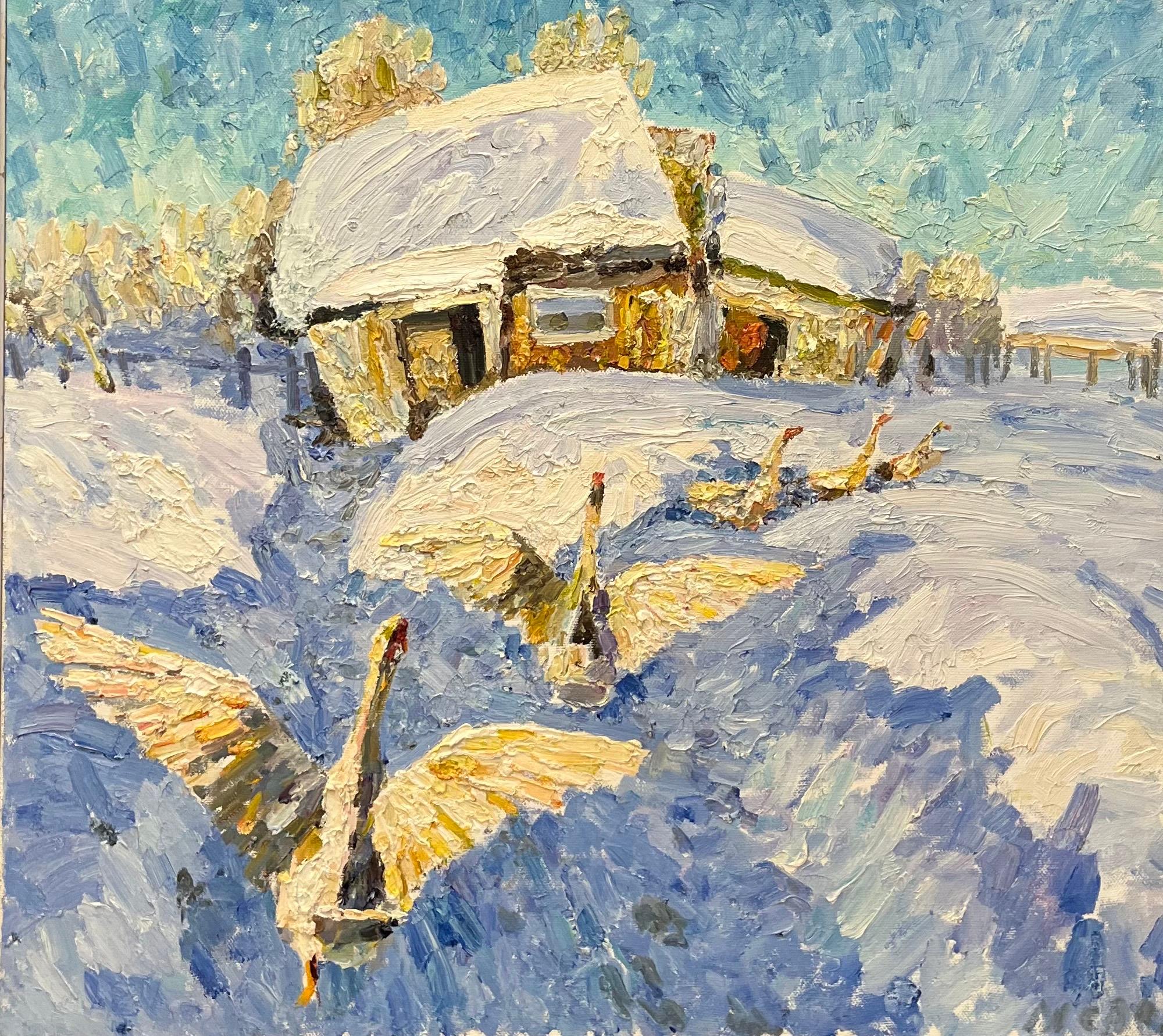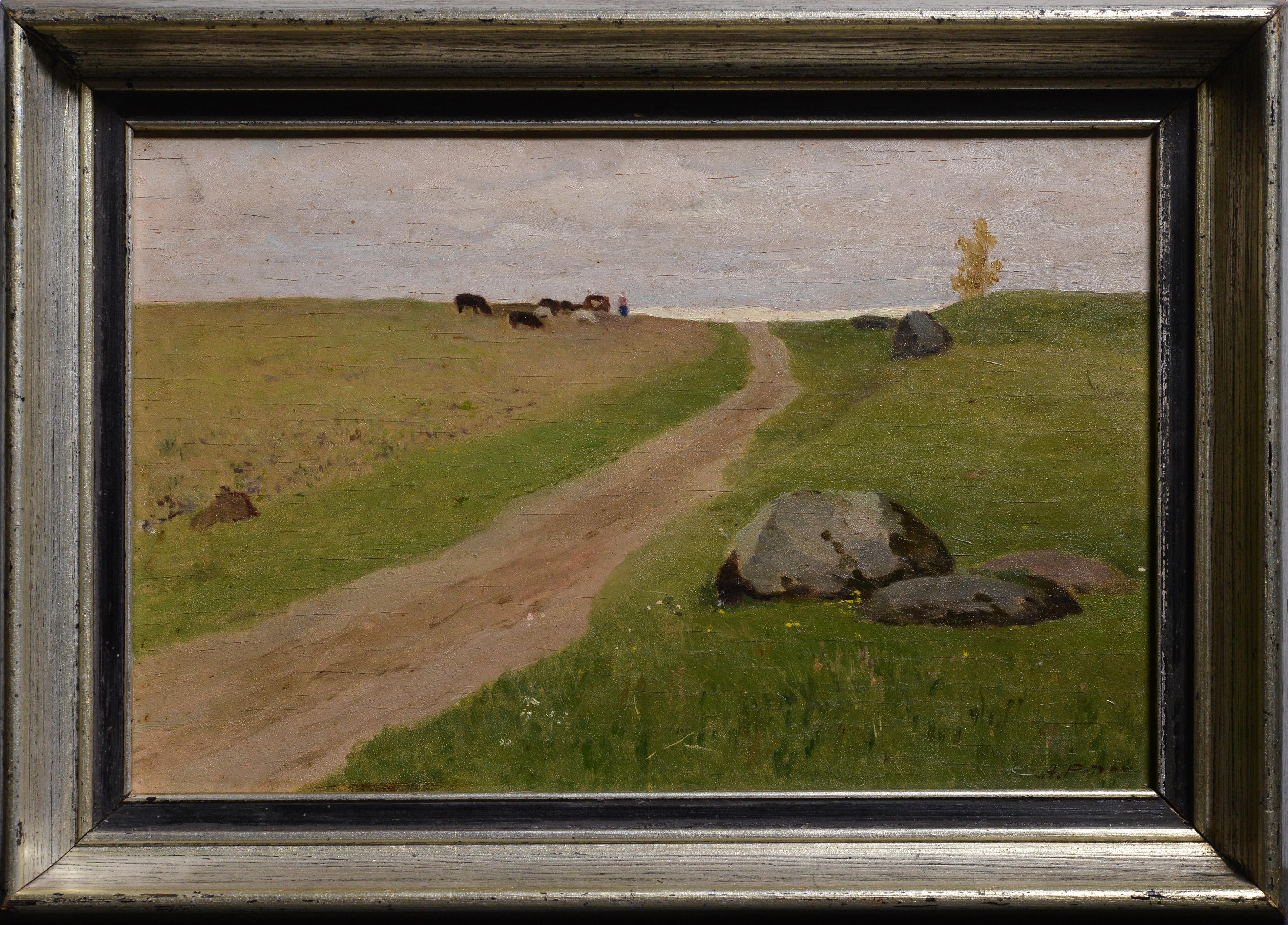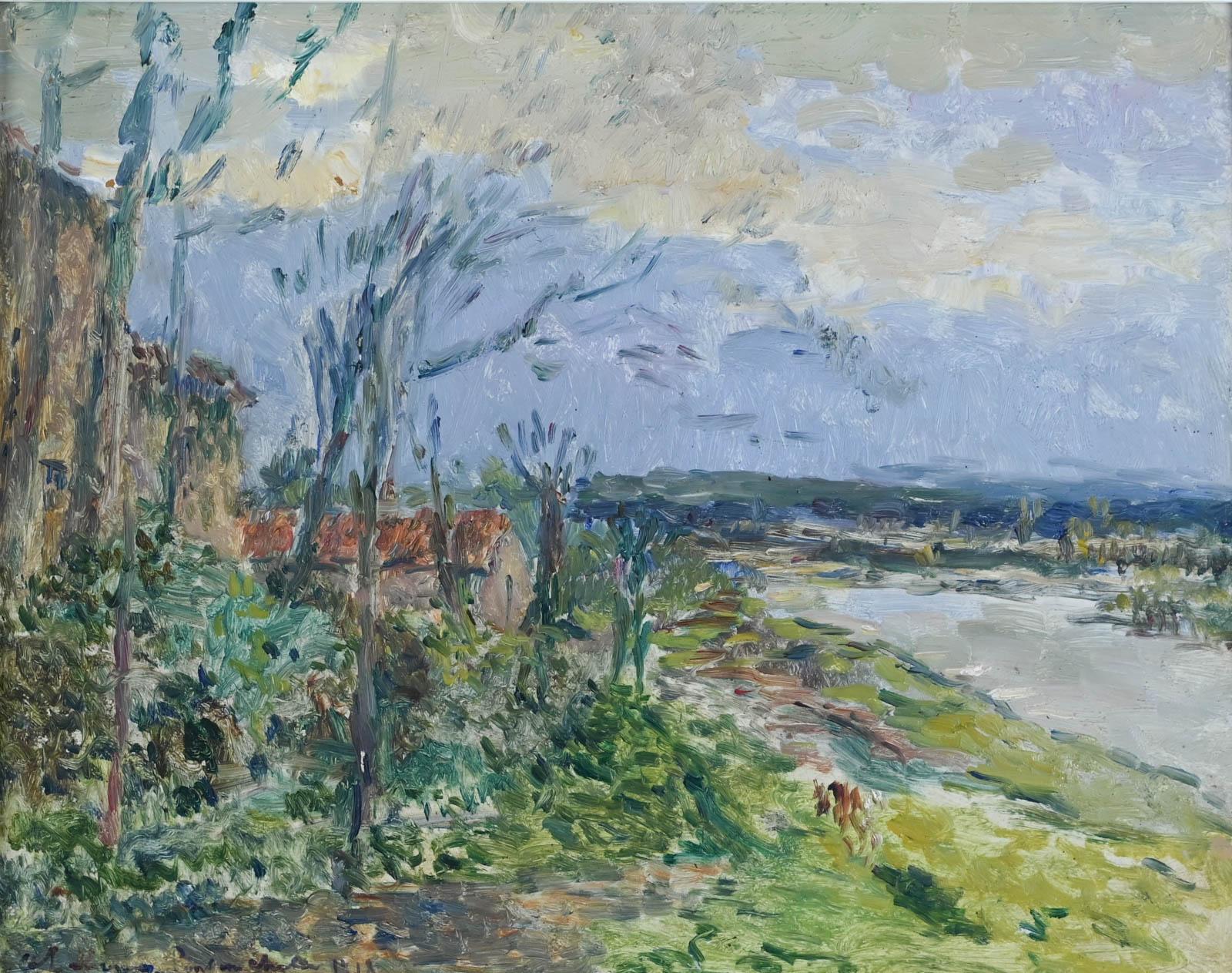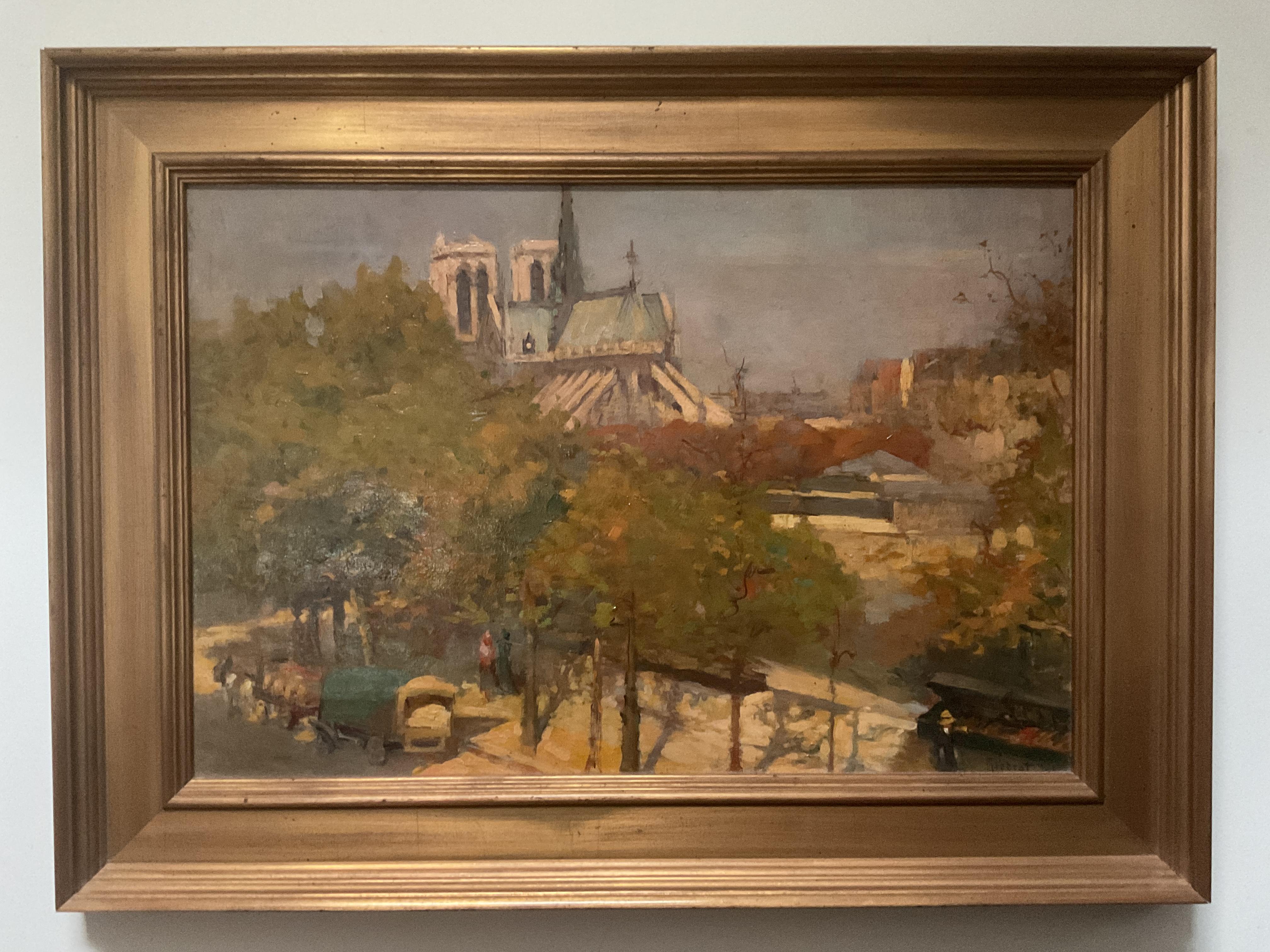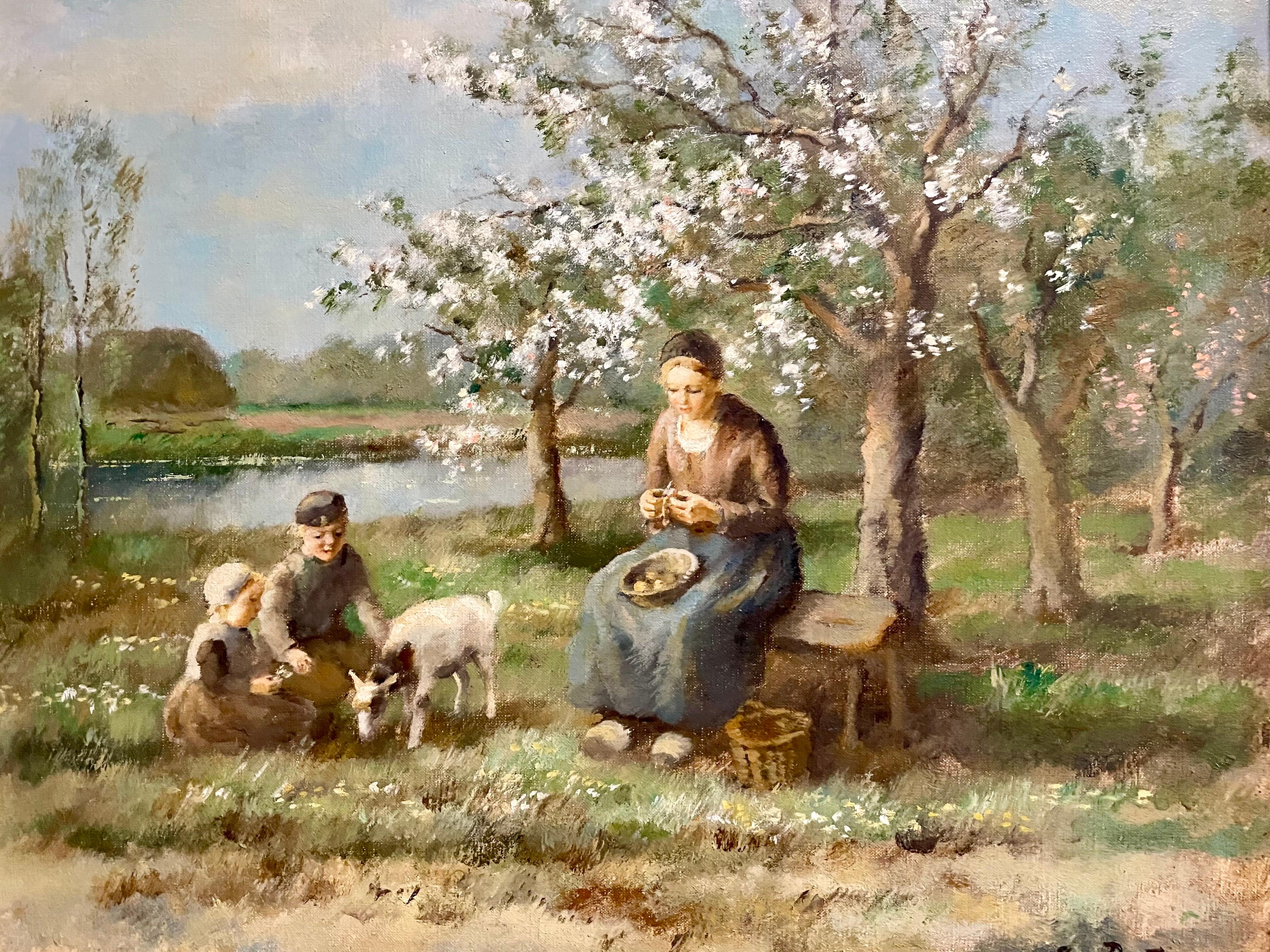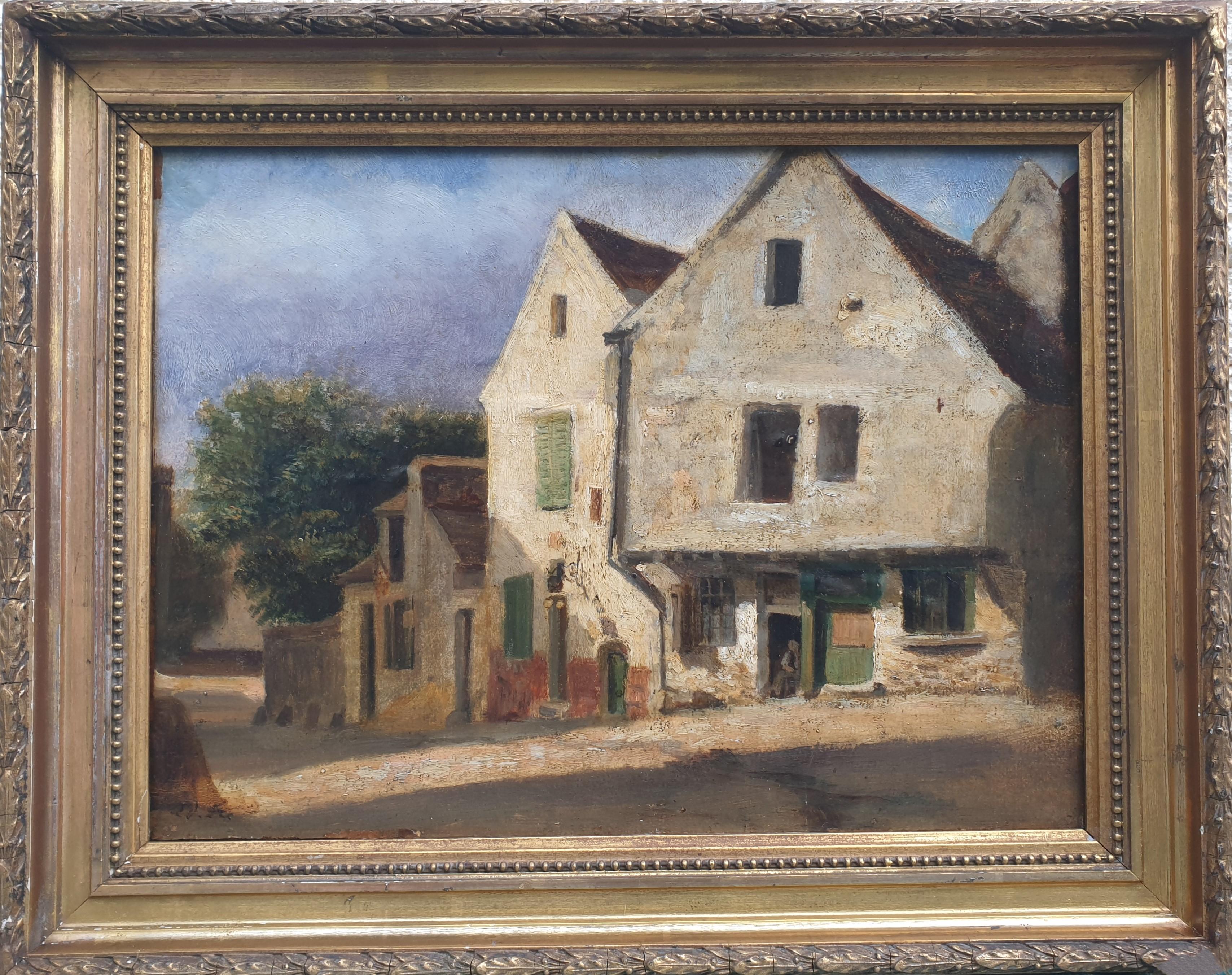Items Similar to "AUTUMN PATH" TEXAS HILL COUNTRY RARE G. DAY SIGNATURE
Want more images or videos?
Request additional images or videos from the seller
1 of 8
Robert W. Wood"AUTUMN PATH" TEXAS HILL COUNTRY RARE G. DAY SIGNATURECirca 1940
Circa 1940
About the Item
Robert Wood (G. Day)
(1889 -1979)
San Antonio Artist
Size: 12 x 16
Frame: 16 x 20
Medium: Oil
"Autumn Path"
Biography
Robert Wood (G. Day) (1889 -1979)
A painter of realistic landscapes reflecting a vanishing wilderness in America, Robert Wood (not to be confused with Robert E. Wood) is reportedly one of the most mass-produced artists in the United States. His painting became so popular he was unable to meet all of the demands, and many of his works were reproduced in lithographs and mass distributed as prints, place mats, and wall murals by companies including Sears, Roebuck. He was born in Sandgate, Kent on the south coast of England near Dover, the son of W.L. Wood, a famous home and church painter who recognized and supported his son's talent. In fact, he forced his son to paint by keeping him inside to paint rather than playing with his friends. At age 12, Wood entered the South Kensington School of Art. As a youth, he came to the United States in 1910, having served in the Royal Army, and he never returned to England. He traveled extensively all over the United States, especially in the West, often in freight cars, and also painted in Mexico and Canada. His itinerant existence took him to Illinois where he worked as a farmhand, to Pensacola, Florida where he married, briefly in Ohio, Seattle, Washington, and Portland, Oregon. In 1912, he was in Los Angeles, and In the late 1920s and early 1930s, in San Antonio, Texas, where he lived and in 1928 exhibited in the "Texas Wildflower Competition." From San Antonio, he gained a national reputation for his strong colored, dramatic paintings. Some of that prestige has been credited to his association with Jose Arpa, prominent Texas artist. Wood also gave art lessons, and one of his students was Porfirio Salinas. During this period, Wood sometimes signed his paintings G. Day or Trebor, which is Robert spelled backwards. In 1941 he went to California and painted numerous desert and mountain landscapes and coastal scenes. He lived in Carmel for seven years, and then moved to Woodstock, New York, but he soon returned to California, settling first in Laguna Beach, then San Diego, and finally in the High Sierras, where he and his wife built a home and studio near Bishop and lived until his death in 1979. Robert Wood was born March 4, 1889 in Sandgate, England, a small town on the Kentish coast not far from the white cliffs of Dover. His father, W. J. Wood was a successful painter who recognized Robert's unusual talent. At the age of twelve, his father enrolled Wood in art school in the small town of Folkestone. He then attended the South Kensington School of Art. While attending art school, Wood won four first awards and three second awards, one each year, a record. In 1910 after service in the Royal Army, nineteen-year-old Wood and his friend, Claude Waters, immigrated to America. Initially, he settled in Illinois and worked as a hired hand on a farm belonging to Water's uncle. He would then strike out on his own, living the life of an itinerant painter. Wood traveled as a hobo, hopping freight trains and selling or bartering small paintings to support him along the way. When times were hard, he worked at whatever job was available. In this manner, he saw most of the United States and fell in love with rural America. By 1912, Wood visited Los Angeles for the first time, arriving on the day of the Titanic tragedy. Later that year, he had met, courted and married young Eyssel Del Wagoner in Florida. The couple moved to Ohio where a daughter, Florence, was born. During World War I, the family moved to Seattle where a son, John Robert Wood, was born in 1919. In the early 1920's, the young Wood family was almost constantly on the move. They stayed for short periods in Kansas, Missouri, California and for a longer time in Portland, Oregon, where Wood's friend Claude Waters had settled. Wood's seemingly endless wanderings disrupted his family life and delayed his development as a painter. However, through his travels he developed an appreciation for the American landscape that would inspire him for the rest of his career. Although aware of the current movement away from traditional realism in American art, he elected to travel that solitary path and remain true to his own vision of America's grandeur and beauty poetically translated through his landscape and seascape paintings. In 1923, the Wood family discovered the beautiful city of San Antonio, Texas and it was there that he and his family would finally settle. He studied briefly at the San Antonio Art School with Spanish colorist Jose Arpa y Perea (1860-1952), who had arrived in San Antonio that same year. In the latter part of the 1920’s, Jose Arpa’s influence quickly became evident. Wood after several years of experimentation was becoming a fine easel painter, capable of great subtlety with a new mature original style. Like Texas painters Robert Onderdonk (1853-1917) and his son Julian Onderdonk (1882-1922), Robert Wood concentrated on the distinctive Texas landscape with its Red Oak trees and wildflowers that covered the hill country landscape. He developed a reputation for his scenes of Blue Bluebonnets, the state flower. In the spring, the Texas prairie is covered with wildflowers, especially in the hill country surrounding San Antonio and Austin. Wood incorporated native stone barns and rough wood farm houses that added authenticity and romance to his compositions. In 1925, Wood was divorced from his wife. In 1932, he moved to the famous scenic loop on San Antonio's outskirts. While still living in Texas, he took extensive western sketching trips that brought him to California. It is evident that his 1930’s California and Texas works started to show his awareness of the then popular California Plein-Air movement. These more mature works are distinguished by a fine sense of detail reminiscent of late-19th-century American landscape painters laced with the colorful influence of American and French impressionism. With paintings being shipped to dealers across the continent, Wood’s reputation with collectors was growing nationally. It should be noted that from 1924 and 1940 Robert Wood also signed his paintings G. Day (Good Day) and Trebor (Robert backwards). He only used these signatures during these years (1924- 1940) and there is conflicting information as to why. In 1941 after seventeen years in Texas, Robert Wood and his second wife Tula, who he had met in San Antonio, moved to the coastal town of Laguna Beach, California. Laguna had been an artist colony since early in the century and it was the birthplace for California Plein-Air School, which was still active. While in Laguna, he developed a following for both his landscapes and marine paintings. Wood's paintings of the California coast remained a significant part of his oeuvre. Living in Laguna for seven years, Robert Wood became an active member of the Laguna Art Association and an exhibitor at the annual Laguna Festival of the Arts. After the War in 1948, the Woods moved east and bought a home in Woodstock, New York, which he had visited in the 1930’s. It was a popular artist colony located in the Catskills Mountains. He purchased a studio hidden deep in the Wood Stock forest where Maples and Elms, as well as a quiet brook surrounded his small rustic studio. He found inspiration from the bold autumn colors of the forest, the Catskill Mountains covered in pillows of snow and the blossoming fruit trees of spring. During this period, he made sketching trips to New Hampshire, Vermont and along the Maine coast. Although included in his eastern subjects, these Vermont, New Hampshire and Maine subjects are rare when compared to the hundreds of paintings done while in Woodstock. The public was captivated with Roberts Wood’s seasonal Woodstock paintings. He began working with an inexpensive print publishing house (possibly Donald Art Publishing Co.) to reproduce several of his paintings. The reproductions were an immediate success. October Morn, which was his most successful print, sold more than one million copies in less than two years. These inexpensive paper reproductions made Robert Wood one of America's most famous landscape painters. After a few years in New York, Robert and Tula moved back to Laguna Beach. 1952 and 1953 were tumultuous years for Robert Wood. He and Tula became increasingly estranged and they were divorced in 1952. The following year, Wood was hit by a car on Pacific Coast Highway and nearly died. His friend and amateur artist Caryl Price helped him around the house during his recovery and the two were soon married. He had instructed Caryl in painting and he would take her on sketching trips all throughout the west. During the 1950's, a combination of the popularity of Robert Wood's paintings and his print royalties eventually made him a comfortable living. It was during this period that Grand Tetons became a favorite subject. Although Robert Wood painted extensively in the Colorado Rockies in the 1930s and 1940s, he did not paint the Tetons until the late 1950s. By the early 1960s, the Tetons and the California coast made up a significant percentage of his artistic production. Wood would continue to paint his popular Texas landscapes but his style had changed. Works from this period are more broadly painted with a more chromatic palette, which was considerably different than those from the 1930s and 1940s. In the 1960's, Robert Wood found great success and his paintings brought higher prices, some selling in excess of five thousand dollars. At the age of eighty, the American Express Company commissioned him to paint a series of six works to be reproduced as limited edition serigraphs for their Cardholders. Each print depicted one of the National Parks, subjects that were well known to Wood. Around 1964, Robert and Caryl Wood moved to San Diego. They had purchased a wonderful Victorian house that Caryl wanted to restore. After several years in San Diego, they finally moved back to Bishop and the Sierras. Wood remained active and he continued to paint until just prior to his death in the spring of 1979, just weeks before his 90th birthday. Although Robert Wood shunned publicity and was modest about his accomplishments, he had millions of admirers who mourn his passing. There are thousands of artists in this country who learned a great deal by studying his work, his reproductions and through the art instruction books he authored for Walter Foster publishing.
- Creator:Robert W. Wood (1889 - 1979, American)
- Creation Year:Circa 1940
- Dimensions:Height: 16 in (40.64 cm)Width: 20 in (50.8 cm)Depth: 3 in (7.62 cm)
- More Editions & Sizes:Size: 12 x 16Price: $5,040
- Medium:
- Movement & Style:
- Period:
- Framing:Frame IncludedFraming Options Available
- Condition:Please visit my storefront for more vintage and mid-century artwork.
- Gallery Location:San Antonio, TX
- Reference Number:1stDibs: LU769312675112
About the Seller
5.0
Vetted Seller
These experienced sellers undergo a comprehensive evaluation by our team of in-house experts.
Established in 1974
1stDibs seller since 2017
82 sales on 1stDibs
Typical response time: 1 hour
- ShippingRetrieving quote...Ships From: San Antonio, TX
- Return PolicyThis item cannot be returned.
More From This SellerView All
- "STAGING ON THE SOUTHERN ARIZONA TRAIL" STAGECOACH ARIZONA / CALIFORNIABy Marjorie ReedLocated in San Antonio, TXMarjorie Reed a.k.a. Harvey Day (1915-1996) California, Arizona Artist Image Size: 16 X 20 Frame Size: 22 X 26 Medium: Oil on Canvas "Valley of the Monuments"Category
20th Century Impressionist Landscape Paintings
MaterialsOil
- "Golden Autumn" Yellows, Reds, Aspens Gorgeous Fall ColorsBy Eugene ThurstonLocated in San Antonio, TXEugene Thurston (1896 - 1993) El Paso Artist Image Size: 40 x 30 Frame Size: 52 x 42 Medium: Oil "Golden Autumn" El Paso Biography Eugene Thurston (1896 - 1993) A prominent early Texas...Category
1950s Impressionist Landscape Paintings
MaterialsOil
- "Texas Hill Country Creek" A Gentle Softness is apparent in this lovely pieceBy Jerry RuthvenLocated in San Antonio, TXJerry Ruthven (1947 - present) Austin Artist Image Size: 24 x 36 Frame Size: 32 x 44 Medium: Oil Dated 1982 "Texas Hill Country Creek" Bio: Jerry ...Category
1980s Impressionist Landscape Paintings
MaterialsOil
- "Facade of San Fernando" Cathedral in Downtown San AntonioBy Randy PeytonLocated in San Antonio, TXRandy Peyton (1958 - present) San Antonio Artist Image Size: 60 x 48 Medium: Oil on Canvas "Facade of San Fernando Cathedral" Biography Randy Peyton (Bo...Category
Early 2000s Impressionist Landscape Paintings
MaterialsOil
- "Summer Splendor" Texas Hill Country Prickley Pear Cactus in Bloom WildflowersBy Eric HarrisonLocated in San Antonio, TXEric Harrison (Born 1971) Texas Hill Country Artist Image Size: 40 x 30 Frame Size: 50 x 40 Medium: Oil 2019 "Summer Splendor" Bio Eric Harrison “I went to the woods because I wished to live deliberately, to front only the essential facts of life, and see if I could not learn what it had to teach, and not, when I came to die, discover that I had not lived.” -Henry D. Thoreau Eric Harrison-born 1971 in San Antonio, Texas. In 1995 he married Kim Marie, and together they have two sons, Noah and Ethan. The Harrison’s reside in the hill country west of Blanco, Texas. Currently painting in a language resonant with other Texas artists such as Robert and Julian Onderdonk, Robert Wood, Porfirio Salinas, Dawson Dawson-Watson, and Robert Harrison; with an affinity toward the work of California painter William Wendt. Paul Cezanne and many of the post impressionists. Exhibitions and collections of his work include: The United States Embassy in Togo, Africa The University of Texas at San Antonio The Buckhorn Museum San Antonio Best of the Best Art Show Salado, Texas Texas Landscape Show The Nave Museum, Victoria Texas The Harrisons, “A Family of Texas Painters” Charles Morin Fine Art...Category
2010s Impressionist Landscape Paintings
MaterialsOil
- "LATTICE ROSE" LOVELY LADY IN A GARDEN.Located in San Antonio, TXRichard Johnson (Born 1953) Chicago Artist Image Size: 40 x 30 Frame Size: 48 x 38 Medium: Oil "Lattice Rose" Richard Johnson (Born 1953) Richard S. Johnson The luminescent beauty and lyrical quality of Richard S. Johnson's work is what captivates collectors today. "Old Masters" technical virtuosity, pre-Raphael romanticism, and contemporary expressionism and abstraction all combine to create his unique works of touching depth and artistry. Rick's expressive skill for capturing the human form has brought him to the attention of the international art world. He was most recently profiled in the January 2009 edition of The American Art Collector and his skill has brought him numerous commissions: John F. Kennedy at the JFK Memorial Library in Boston, A commemorative painting of the presidents from Eisenhower to Bush currently hanging at the President's Council on Physical Fitness in Washington D.C. Rear Admiral Richard S. Truly, USN, the first commander of the NASA Space Shuttle...Category
21st Century and Contemporary Impressionist Figurative Paintings
MaterialsOil
You May Also Like
- "Geese in the snow" oil cm. 100 x 80By Georgij MorozLocated in Torino, ITSnow, geese,white,Ukraine Georgij MOROZ (Dneprodzerzinsk, Ucraina, 1937 - St. Petersburg, 2015) 1937: he was born in Dneprodzerzinsk, Ucraina. 1949-56: he began artistic studies in ...Category
Early 2000s Impressionist Animal Paintings
MaterialsCanvas, Oil
- Latvian Pastoral Field Landscape by Petrovs first half 20th century Oil PaintingLocated in Stockholm, SEAttributed by Aleksandrs Petrovs (1874-1956). This fine painting depicts a serene Latvian pastoral landscape, with a winding road leading to the horizon through endless fields. Immer...Category
Mid-20th Century Impressionist Landscape Paintings
MaterialsWood, Oil
- Pont du ChâteauBy Albert LebourgLocated in LE HAVRE, FRAlbert LEBOURG (1849-1928) Pont du Château, 1918 Oil on panel Size : 33 x 42 cm Signed and dated 1918 lower left. Origin : - Galerie Tuffier, Les Andelys, - Private collection, Pa...Category
1910s Impressionist Landscape Paintings
MaterialsOil, Panel
- Antique Paris and Notre Dame Impressionist Oil Painting, ca 1920; Maurice PerrotLocated in Baltimore, MDThis is an early and one of the finest Parisian paintings that Maurice Ferdinand Perrot produced during his long career. The scene depicts early morning light washing the area along ...Category
1920s Impressionist Landscape Paintings
MaterialsOil
- In the Meadow, Springtime DutchBy Cornelis BouterLocated in Hillsborough, NCSpringtime, 'In the Meadow' by Cornelis Bouter (1888-1966) is a Dutch painting with figures and landscape in an impressionist style with early spring blossoms. Idyllic scene by a river under tree blossoms, this fine oil on canvas painting is very well presented in an original frame. Children play while mother peels apples in a pleasant afternoon setting. Sure to please this Easter! Imported by Saltire...Category
Early 20th Century Impressionist Figurative Paintings
MaterialsCanvas, Oil
- Pierre Edouard FRERE Vue maisons Montfort L'Amaury Yvelines Impressionnist 19thBy Pierre Edouard FrereLocated in PARIS, FRPierre Edouard FRERE Paris, 1819 - Ecouen, 1886 Oil on paper on canvas Signed lower left "Ed. Fr" 24.5 x 33 cm (32 x 39 cm with the frame) Beautiful 19th century frame with canes and...Category
1870s Impressionist Landscape Paintings
MaterialsOil
